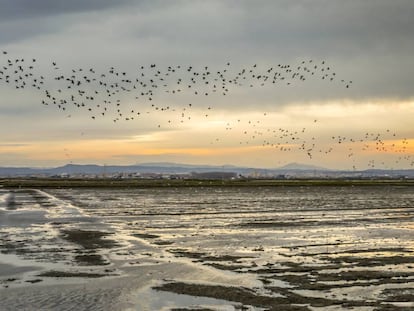Mar Menor: Nature’s payback
A saline lagoon in Spain’s southeastern region of Murcia has become a symbol of how a lack of respect for the environment can backfire. This popular spot made global headlines in October when thousands of dead fish washed up on shore. EL PAÍS traveled to what was once an idyllic spot to find out how things got this bad
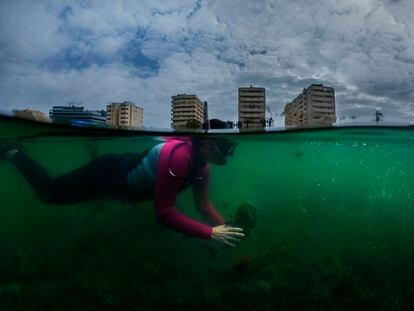
In the popular summer resort of La Manga del Mar Menor, in front of apartment blocks and street cafés that sit empty and shuttered at this time of the year, a diver disappears into the depths of the lagoon. Her name is Francisca Giménez Casalduero and she is a researcher at the University of Alicante who has been taking samples in this wetland for the last 28 years. Standing here on a recent February day, and despite the clear waters, the biologist delivers a shocking diagnosis: “At a depth of below three meters, the lagoon is absolutely dead; there is nothing. And above that, there is still some life, but the situation is dire.”
Despite its name, the Mar Menor is not a sea but a saline coastal lagoon in Murcia spanning 135 square kilometers and separated from the Mediterranean Sea by a 22-kilometer long strip of land (La Manga, meaning “the sleeve”) that is no wider than 100 meters at various points.
It is a unique saltwater ecosystem, boasting five volcanic islands and a biodiversity particular to this spot. But the Mar Menor is also a stark example of how contempt for the environment can backfire. There are many reasons why the lagoon is no longer the picture of health. First there was the dumping of waste from mining, then unfettered construction, and finally the nitrates from intensive agriculture that seeped into the water for decades, contributing to the collapse of the ecosystem.

But if one had to pinpoint a specific moment when the landscape was completely transformed, it would be during the 1960s with the development of La Manga, where Giménez Casalduero is now carrying out her research.
It all started when a lawyer named Tomás Maestre Aznar managed to acquire sole ownership of the narrow strip of sand dividing the Mar Menor from the Mediterranean. At the time, this place was a practically a wilderness. Considered of little value, he took it off the hands of members of his own family and other heirs of the former mining business.
Thanks to his contacts within the Franco regime, Maestre worked to ensure that this strip of apparently useless land would become one of the chosen locations for the regime’s decisive investment in the tourist industry. Once the deal was sealed, the Catalan architect Antonio Bonet, who had worked in Paris with Le Corbusier, came on board. He was commissioned to design a luxury tourist enclave that would attract foreign visitors to that magical but deserted spot.
“La Manga was then a desert between two seas; it was all dunes,” says Victoria Bonet, the architect’s daughter, who explains how the project envisioned by her father had nothing to do with what came later. “I was eight or nine years old then, but I spent a lot of summers there because my father had to visit the site to keep tabs on the construction work.”
In his drawings, Antonio Bonet designed a series of small, developed areas combining high-rises and villas and separated by stretches of green belt. But Maestre and the proponents of mass tourism had other ideas. “It became impossible [for my father] to have his vision respected,” adds Victoria Bonet.

Many of Victoria’s childhood memories involve the lagoon. “Summers meant the beach and the outdoors,” she says. “Sometimes we would feel adventurous and take a rickety old boat and go to one of the islands. Diving into the water was bliss: the Mar Menor was stiller than the Mediterranean and you could see the seabed much more clearly. For me, that kind of life was luxury, but it had nothing to do with money.”
But for others, it was all about the money. With the end of Franco’s regime and the 1973 oil crisis, the project began to unravel. To meet his debt obligations, Tomás Maestre began to pay suppliers, bricklayers and plumbers with plots of land. According to José Luis Domínguez, author of several books on the history of La Manga’s development, that was when everything went crazy and every last square meter between the two bodies of water was sealed with concrete and brick. “In the 1980s, my father was already pained by La Manga,” says Victoria Bonet. “He saw how excessive greed had destroyed a paradise. Friends would call him to come down for a weekend but he would say no, because he didn’t want to see it, because it hurt.”
The development of La Manga not only established a model of excessive construction in the area – the number of ports per kilometer of coastline is almost five times that of the Balearic Islands – it also had a major impact on the lagoon itself. Besides the sewage and other fallouts from tourism, something happened between 1974 and 1975 that affected the ecosystem in a very specific way: in order to allow larger boats to enter the Tomás Maestre marina, the Estacio channel, which connected the wetland with the Mediterranean, was expanded. This made way for the yachts, but also for the seawater, completely altering the lagoon’s ecosystem. Its levels of salinity dropped, and species from the Mediterranean began to migrate and colonize the wetland, such as a type of algae known as Caulerpa prolifera.
Right around that time, another huge project was about to transform agriculture in the nearby fields of Campo de Cartagena: the water transfer between the Tagus and Segura rivers, which would ultimately have an equally devastating effect on the lagoon. Hundreds of square kilometers of fields that had been cultivated with dryland farming techniques now began to be irrigated and fertilized. The effects of this intensive agriculture were felt several kilometers away. As the biologist Francisca Giménez Casalduero explains, “Just as they boosted the growth of lettuces, the nitrates that reached the lagoon began to make the algae grow and the bottom became covered with Caulerpa. This is the first symptom of eutrophication – seabeds that become dominated by this type of algae due to an excess of nutrients. What is happening in the Mar Menor is textbook stuff. It has been well researched.”

Within the space of a few years, the underwater landscape had changed as much as the out-of-water one. While there is not much prior scientific data on the species that inhabited the lagoon, by the 1980s fishermen were already noticing that something was wrong – their catch was becoming smaller. Jesús Gómez, the former head of San Pedro del Pinatar’s fisherman’s guild, was left with no alternative but to sell his two small boats for artisan fishing and buy a larger seiner that could cope with the Mediterranean instead. “We fishermen could see it,” he says. “The balance of the ecosystem had changed, production went right down, and although the lagoon was recovering after 1995, it had already transformed: of the dozen profitable species we had previously fished, only three or four were left.”
There were other warning signs over the years, such as the proliferation of jellyfish in 1990. There were alerts from scientists, complaints in Europe, street protests. In 1996, the environmental organization ANSE even used a hot-air balloon to advertise its concerns for the Mar Menor. But to little avail. What did make people sit up and take notice was when the lagoon turned green in 2016; ANSE posted a video of a diver submerged in a what looked like a thick green soup. Yet what was happening beneath the surface was even worse.
“What happened in 2016 with the ‘green soup’ was a severe eutrophication crisis,” says Giménez Casalduero. “The nitrates entering the water make the phytoplankton grow and become so dense that it doesn’t allow light to pass through. That means that the vegetation below three meters cannot perform photosynthesis, so it dies. The decomposition caused by the bacteria in turn prevents the diffusion of oxygen, which kills all the fauna at that depth.”
This episode represented a quantum leap in the lagoon’s crisis, as 85% of life on the bottom was lost and replaced by a bed of mud. “Before 2016 the estimated population of fan mussels – large bivalve mollusks on the verge of extinction – was more than one million; after 2016, there were between 3,000 and 4,000, and now there are even fewer,” adds Giménez Casalduero.
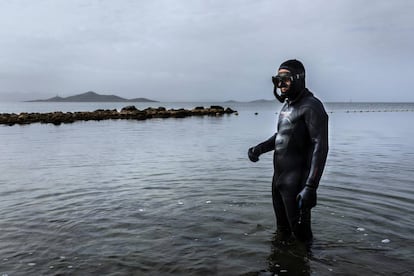
In April 2019, officers from the Civil Guard entered 67 agricultural properties in Campo de Cartagena with helicopter back-up to carry out inspections. The operation, codenamed Chandos, was linked to a case opened in 2017 by Murcia’s senior prosecutor, José Luis Díaz Manzanera, to investigate the degradation of the Mar Menor.
Thirty-five illegal wells and 38 unauthorized plants to treat brackish water were found and shut down. The most shocking aspect of this operation is that several of these facilities were hidden underground. One desalination plant had even been set up on a trailer so it could be moved easily between wells before being concealed again in a warehouse or garage. The Chandos operation is ongoing, with almost 100 people under investigation so far.
In the criminal complaint that triggered the judicial case, prosecutors argued that the root of the problem lies in the excessive and uncontrolled plowing of the Campo de Cartagena for irrigation crops following the Tagus-Segura water transfer. Because there was still not enough water for everyone, many farmers began to extract poor-quality water from illegal wells that tapped underground aquifers, and then resorted to small desalination plants, which number around 1,000 and almost all of which lack a license and an environmental impact certificate.
But what is pumped out is not only salty, it is also contaminated, so when the salt is removed, the resulting brine is loaded with nutrients. This waste is thrown away and ends up in the Mar Menor. The Segura Water Authority (CHS) built a network of pipes with public money that the farmers could use to get rid of the brine from these desalination plants. This infrastructure was supposed to collect the waste, but it almost never worked, nor was it properly maintained. Instead, the concentrated nitrates ended up in the Albujón riverbed, the main gateway to the lagoon. The useless pipe network was eventually torn down in 2017.
In his brief, the prosecutor charges farmers and public officials with consenting to this situation and failing to take any measures to prevent it. Among the accused is Antonio Cerdá, the former regional chief of agricultural affairs for Murcia, who held the position from 1999 to 2015, as well as the former heads of CHS, José Salvador Fuentes Zorita and María Rosario Quesada. Last October, for the first time, the CHS reported at least 9,500 hectares in the Campo de Cartagena that had no irrigation concession.
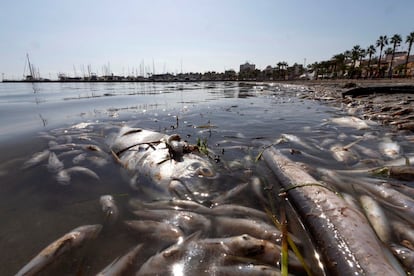
“We are not criminals,” says Manuel Martínez, president of the Campo de Cartagena Irrigation Association. Twenty percent of the horticultural products that Spain exports to other countries come from this region of Murcia, including lettuce, melons, broccoli, oranges and peppers. Representing 9,800 farmers in the area, Martínez is particularly upset with a report on the Mar Menor crisis that aired on German television just as the agricultural fair Fruit Logistica 2020 was kicking off in Berlin. “We are making a mistake,” he says. “I was taught that dirty laundry is washed at home. Not that we have anything to hide, but so many exaggerated claims are damaging our image.”
Himself a farmer, Martínez grew up by the Mar Menor. He used to enjoy water-skiing there but he now he rejects the idea that land irrigation is to blame for what is happening in the lagoon. Agriculture nowadays has more technology than a mobile phone, he says, and supplies only the right amount of water to each plant, feeding it drip by drip. “The irrigation techniques used in Campo de Cartagena are among the most advanced in the world,” he says. “Never mind those of Israel and the United States. They come here to learn from us.” He goes on to insist that the sector is being demonized. “The Mar Menor is obviously in a bad state, no one’s denying it. But that we as farmers are responsible for 85% of the discharge as claimed… I need proof.”
Paradoxically, one of the greatest problems of this rain-starved land is the excess of water in the underground Quaternary aquifer. It cannot be drunk or used directly for irrigation because it is brackish and also contaminated. “It doesn’t just happen here, there are many aquifers in agricultural areas across the country that are contaminated with nitrates,” says José Luis García Aróstegui, a scientific researcher specializing in aquifers with the Spanish Geological and Mining Institute. According to him, far more contaminated water seeps into the Mar Menor from the subsoil than from what runs off the surface. “Even if all agriculture were abolished right now, the contaminated water in the aquifer would seep out for decades,” he says.
Twenty percent of the horticultural products that Spain exports to other countries come from this region of Murcia, including lettuce, melons, broccoli, oranges and peppers
During the destructive storm that hit eastern Spain in September of last year, the farmer Santiago Pérez Blaya was trapped inside his home in Los Alcázares, Murcia. The water entered his house and rose almost a meter and a half, preventing him from opening the doors. He was stuck for about 10 hours. Rescue workers tried to get him out in vain, and eventually he broke a door down himself. “It’s not that I was afraid I would die,” he says. “But I had a pretty bad time.”
He is understandably fed up with the successive floods in the municipality. “It’s all linked to disastrous land management,” he says. “Agriculture is to blame, but also the golf courses, the industrial parks, the housing estates. As the land has been sealed and natural watercourses have been destroyed, the water runs through the middle of Los Alcázares, which is hellish.”
Pérez Blaya has 80 hectares of land on which he grows lettuce and potatoes. He is also president of the small and medium farmers’ association Proagua. According to him, the big intensive farming companies are swallowing up everything in their path. “They are ruining us, because the [profit] margins are getting smaller and smaller,” he says. With regard to the Mar Menor, he says: “We have all been guilty here, but there have been some people with excessive ambitions to make money who the politicians have given in to.”
After a respite from the green soup crisis, 2019 saw the wetland once again in a critical state. And then came the September storm that flooded Los Alcázares. As Ángel Pérez Ruzafa, professor of ecology at the University of Murcia, explains, the massive influx of fresh water created a surface layer over the lagoon that cut the spread of oxygen underneath with fatal consequences. On October 12, Villananitos beach in Lo Pagán filled up with dead fish; the Mar Menor had spat out a mass of silvery corpses and fish gasping their last, including sea bass, shrimps, eels and crabs.
One of the people on the beach that day was Jesús Gómez, the former head of the fishermen’s guild. “I’m not a sentimental type, but I felt like crying,” he says. He was not the only one who was deeply disturbed by the images of the dead fish. A few days later, 55,000 people took part in the largest demonstration to date against the state of the lagoon in Cartagena, a city of 213,000 inhabitants. “We are pained by the situation, but we are also angry,” said Isabel Rubio, representative of the citizen’s organization Pact for the Mar Menor. “This is an ecosystem that has been spoiled by the incompetence of the politicians in the region.”
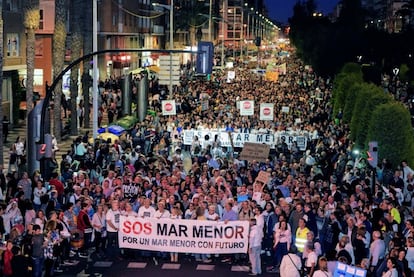
The situation remains critical. According to Pérez Ruzafa, who is also the spokesman for the Mar Menor Scientific Advisory Committee, the solution lies in infrastructure that can control the water. “How do you solve the problem of urban wastewater? By building a sewage system and treatment plants. If agriculture is to be made compatible with ecological integrity, you have to find a similar solution,” he says.
But, according to Pedro García, the head of ANSE, this would not go far enough. “The intensive agricultural area has to be reduced,” he says. “And regarding urban planning, we have to consider selective demolition in vulnerable areas or in areas with very serious flooding problems.”
How much worse can a wetland like this get? In 2017, Salvador García-Ayllón Veintimilla, professor at the Polytechnic University of Cartagena, published a study in the scientific journal Ocean & Coastal Management comparing three lagoons in different states of crisis – Mar Chica (Morocco), Mar Menor (Spain) and Salton Sea (USA). The worst off is the Salton Sea, a wetland in California almost seven times larger than the Mar Menor, located in the agricultural belt of the Imperial Valley. “If you want to know what the Mar Menor could look like a few years down the line, the case of Salton Sea is very telling,” says García-Ayllón Veintimilla.
In 1950s and 1960s, Salton Sea was a fashionable vacation destination for the likes of Frank Sinatra and Jerry Lewis. But the Californian lagoon started to rot and ended up with a beach of dead fish and a dreadful smell. When this reporter visited the spot some years back, the resort had become a ghost town. The only people left now are Hispanic immigrants and farm laborers. They shut themselves away in their houses, and keep the windows firmly shut to protect themselves from the flies and the stench.
English version by Heather Galloway.



